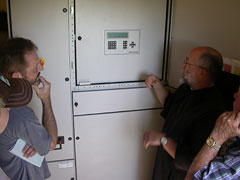Portsmouth Wind Workshop tours Abbey Turbine
 About 20 residents gathered at Portsmouth Abbey today for a discussion of proposed Portsmouth Wind energy initiatives and a tour of the school's wind turbine. The workshop, the third one this week, was conducted by the Portsmouth Economic Development Committee as input for a potential bond issue on the November ballot.
About 20 residents gathered at Portsmouth Abbey today for a discussion of proposed Portsmouth Wind energy initiatives and a tour of the school's wind turbine. The workshop, the third one this week, was conducted by the Portsmouth Economic Development Committee as input for a potential bond issue on the November ballot.
"This is part of the feasibility study," said EDC Chair Rich Taplisky. "We want you to feel that you're really informed." He noted that there had been lots of good questions at all the workshops, and that everything would be added to the growing FAQ at the Web site for the initiative, PortsmouthRIenergy.com.
The session kicked off with a series of walk-around stations with information about wind energy where participants could chat informally and ask questions, then Gary Gump, who leads the Sustainable Energy subcommittee, did a brief PowerPoint presentation. The potential savings are significant, said Gump. Portsmouth uses about 4M kwh of electricity a year, which costs the town about $580K. Of that, the schools represent the largest chunk, almost two-thirds, costing $360K/year. Based on preliminary estimates — and part of the feasibility work is being done by a consultant to refine the numbers — a turbine sited at the Middle or High School could potentially offset the majority of the building's electricity neeed, with a small surplus left over to sell back to the grid. (The apparent contradiction of meeting "most" of the need while having a surplus is due to the fact that peak generation times do not completely overlap with consumption patterns at the school. The wind doesn't pick up until after 10am.)
The upfront cost of installation would be paid through an already approved zero-interest bond, and the finance charges would be paid for from electricity savings, so there would be zero impact on the town budget. And once the turbine was paid off — in about 11 years — the rest of its 25-year-lifespan would bring in about $150K/year for the town. "Over two million in total value over its 25-year lifetime," said Gump, noting that there would be options for refurbishing the equipment at that time to take advantage of the tower infrastructure.
An additional source of revenue that will be factored in are "renewable energy certificates," which clean energy producers (like wind turbines) receive, and which they can then sell to coal- and gas-fired plants to offset their carbon footprint. Brother Joseph, of the Abbey, said that they had received over $65K in revenue from certificates this year.
During the Q&A, one participant asked about issues with folks in the neighborhood, and Brother Joseph said that a key ingredient in their success had been early and frequent communication. "You need to go door to door," said Brother Joseph, noting that he had done this before the installation, a few weeks after, and then after a year. "The responses around here are extremely positive," he said, while admitting that there were a few issues with noise, flicker from the blades at low sun angles, and the red airplane beacons.
Brother Joseph then led the group on a tour of the turbine, opening up the door at the base to reveal an astoundingly simple control panel. A narrow rebar-rung ladder runs up one wall, but although Brother Joseph said he had been up there a couple of times, the actual control could be done remotely from his computer. 
The wind began to pick up just as the tour was over, but even standing directly underneath it, the sound — while audible — was not unpleasant. It really was striking how compact the installation is, essentially the ground footprint is about a fifteen-foot-diameter concrete pad, and because of the height of the rotor, you could site it fairly close to other active areas. You could walk right up to it, and not really notice, until you look up and see these 75-foot-long blades whirling overhead.
"We were going to put it next to the playing field," joked Brother Joseph, describing the potential disorienting impact on visiting teams. "We figured when it started up, it would give us a tremendous home court advantage."